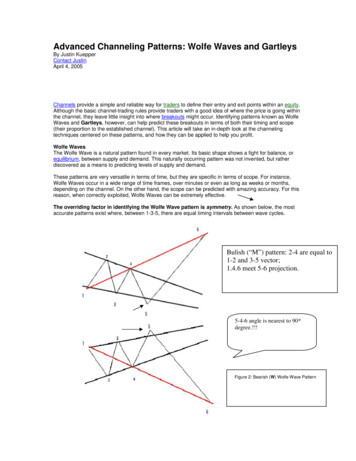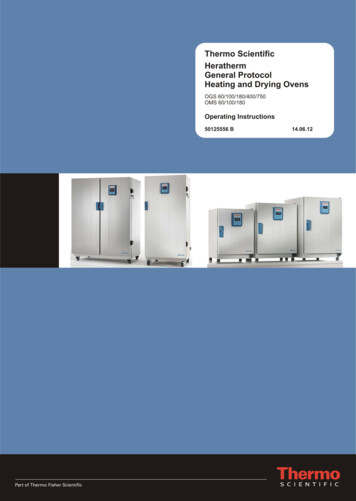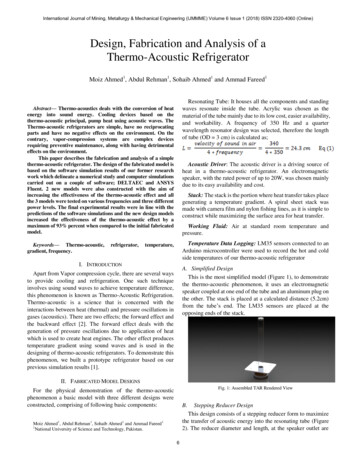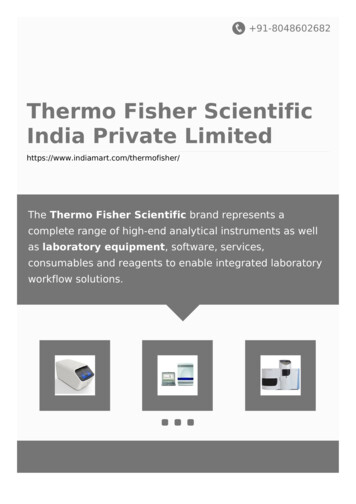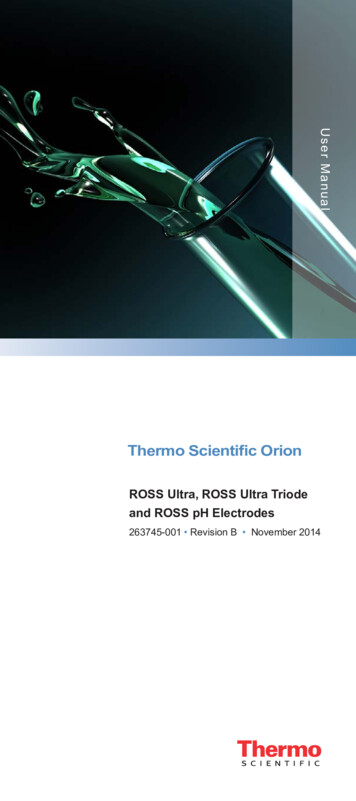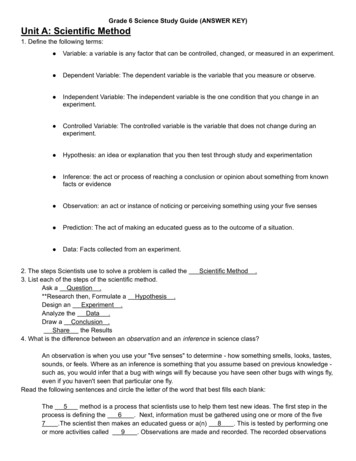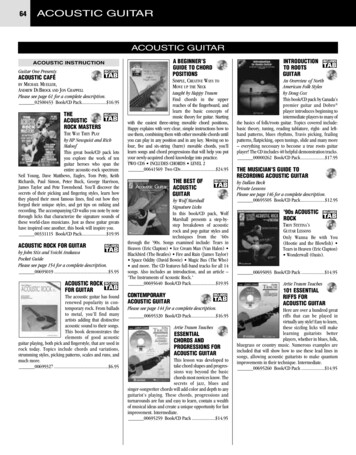
Transcription
GENERATION OF THERMO-ACOUSTIC WAVESFROM PULSED SOLAR/IR RADIATIONbyAowabin RahmanA thesis submitted to the faculty ofThe University of Utahin partial fulfillment of the requirements for the degree ofMaster of ScienceDepartment of Mechanical EngineeringThe University of UtahMay 2014
Copyright Aowabin Rahman 2014All Rights Reserved
The University of Utah Graduate SchoolSTATEMENT OF THESIS APPROVALThe following faculty members served as the supervisory committee chair andmembers for the thesis of Aowabin Rahman. Dates at right indicate the members’approval of the thesis.Kuan Chen, Chair03/17/2014Geoffrey Silcox, Member03/17/2014Kent Udell, Member03/17/2014The thesis has also been approved by Tim Ameel, Chair of the Department ofMechanical Engineering and by David B. Kieda, Dean of The Graduate School.
ABSTRACTAcoustic waves could potentially be used in a wide range of engineeringapplications; however, the high energy consumption in generating acoustic waves fromelectrical energy and the cost associated with the process limit the use of acoustic wavesin industrial processes. Acoustic waves converted from solar radiation provide afeasible way of obtaining acoustic energy, without relying on conventionalnonrenewable energy sources.One of the goals of this thesis project was to experimentally study theconversion of thermal to acoustic energy using pulsed radiation. The experiments werecategorized into “indoor” and “outdoor” experiments, each with a separate experimentalsetup. The indoor experiments used an IR heater to power the thermo-acoustic lasersand were primarily aimed at studying the effect of various experimental parameters onthe amplitude of sound waves in the low frequency range (below 130 Hz). The IRradiation was modulated externally using a chopper wheel and then impinged on aporous solid, which was housed inside a thermo-acoustic (TA) converter. A microphonelocated at a certain distance from the porous solid inside the TA converter detected theacoustic signals. The “outdoor” experiments, which were targeted at TA conversion atcomparatively higher frequencies (in 200 Hz–3 kHz range) used solar energy to powerthe thermo-acoustic laser.
The amplitudes (in RMS) of thermo-acoustic signals obtained in experimentsusing IR heater as radiation source were in the 80–100 dB range. The frequency ofacoustic waves corresponded to the frequency of interceptions of the radiation beam bythe chopper. The amplitudes of acoustic waves were influenced by several factors,including the chopping frequency, magnitude of radiation flux, type of porous material,length of porous material, external heating of the TA converter housing, location ofmicrophone within the air column, and design of the TA converter. The time-dependentprofile of the thermo-acoustic signals also showed “transient” behavior, meaning thatthe RMS amplitudes of TA signals varied over a time interval much greater than thetime period of acoustic cycles. Acoustic amplitudes in the range of 75–95 dB wereobtained using solar energy as the heat source, within the frequency range of 200 Hz–3kHz.iv
TABLE OF CONTENTSABSTRACT . iiiACKNOWLEDGEMENTS . . viiChapters1. INTRODUCTION . 12. LITERATURE REVIEW . 82.1 Photo-acoustic oscillations . 82.2 Thermo-acoustic oscillations and thermo-acoustic converters. 122.3 Research needs and motivations . 163. MATHEMATICAL FORMULATION AND NUMERICAL SIMULATIONS . 203.1 The Rosencwaig and Gersho (RG) model . 203.2 2D numerical simulations of pressure oscillations inside the air column . 253.3 Thermal relaxation time and thermal boundary layer . 374. EXPERIMENTAL SETUP AND PROCEDURES . 424.1 TA laser using IR heater as heat source . 424.1.1 Construction of TA laser powered by IR radiation . 424.1.2 Experimental procedures . 454.2 Solar to acoustic energy converter . 484.2.1 Construction of solar-powered TA laser. 484.2.2 Experimental procedures . 504.2.3 Alignment of pyrometer and lens-chopper-TA converter module . 534.3 Conversion of microphone outputs to decibels . 53
5. RESULTS AND DISCUSSIONS. . 565.1 Analysis of acoustic signal obtained . 565.2 Thermal radiation entering the TA converter . 595.3 Absence of acoustic waves when the air column was open to ambient air . 635.4 Factors affecting amplitude of thermo-acoustic waves .635.4.1 Chopping frequency 635.4.2 Presence of acoustic signal without any porous solid . 655.4.3 IR power level . 675.4.4 Properties of the porous material . 685.4.5 Transient behavior of thermo-acoustic signals . 715.4.6 Effect of preheating the TA converter . 755.4.7 TA converter design . 775.4.8 Location of microphone . 805.4.9 Length of porous material.825.5 Solar to acoustic energy conversion. 845.5.1 Filter configurations . 875.5.2 Analysis of signal obtained . 875.5.3 Magnitude of solar radiation flux in comparison to radiation flux in IRexperiments . 1025.5.4 Transient behavior of thermo-acoustic signals (outdoor tests) . 1035.6 Uncertainty analysis . 1046. CONCLUSIONS 106AppendicesA. MICROPHONE CALIBRATION PLOTS . 109B CAD DIAGRAMS OF THERMO-ACOUSTIC CONVERTERS. 115REFERENCES . 120vi
ACKNOWLEDGEMENTSI would like to acknowledge the contributions of several coworkers whocollaborated with this research. I would like to thank my advisor, Dr. Kuan Chen, whoprovided valuable ideas on theoretical aspects of thermo-acoustics and contributed withpractical suggestions on experimental procedures and interpretation of experimentaldata. I would also like to acknowledge the contributions of Faisal Fathiel, who designedand machined TA converters and the experimental rig for the solar to acoustic energyconverter, Dr. NJ Kim, who built the rig for the IR heater, and Mohammad Albonaeem,who helped with the uncertainty analysis of the experimental data.This work was partially supported by a grant (No. 2011-0029820) from theNational Research Foundation of Korea, which is greatly appreciated.
CHAPTER 1INTRODUCTIONThermo-acoustic oscillations are pressure oscillations that occur due totemperature variations. Sound waves are generally regarded as a combination ofpressure and velocity oscillations of air molecules in space; however, these are coupledwith temperature oscillations as well [1]. Conversely, temperature fluctuations in airinduced by external sources can cause thermo-acoustic oscillations. The origins ofthermo-acoustics can be traced back to 1777, when Bryon Higgins [2] observed thatigniting a hydrogen flame inside a tube open at both ends produces sound waves thatvary with the position of the flame within the tube. Experiments by Rijke and Sondhassconfirmed Higgins’ observations, and Lord Rayleigh suggested a qualitativeexplanation in 1896 [3]:“If heat be given to the air at the moment of greatest condensation, or be takenfrom it at the moment of greatest rarefaction, the vibration is encouraged. On theother hand, if heat be given at the moment of greatest rarefaction, or abstracted atthe moment of greatest condensation, the vibration is discouraged.”Thermo-acoustic energy converters are of interest to engineers as they can be usedas heat engines, where heat flowing through a porous media is converted to sounds [4],or as heat pumps, where externally generated pressure oscillations are used to transferheat from a region of lower to higher temperature [4]. These thermo-acoustic devices
2are easy to construct, and they do not release greenhouse gases. Thermo-acousticdevices can also be used for refrigeration purposes, particularly for cryogenicapplications [5]. Methods of generating large-scale acoustic energy were not explored ingreat detail in the past, mainly due to concerns about the high cost of generatingacoustic energy from electricity as well as potential safety hazards [6]. However, recentdevelopments in solar-powered thermo-acoustic-lasers (TA lasers) [7] and refrigeratorsdriven by waste energy, such as heat from exhaust gases from automobile engines [8,9],or heat from power plants, provided economical means of producing acoustic energy ona large-scale. Employing thermo-acoustic engines and heat pumps in such applicationscan reduce energy consumption as well as greenhouse gas emissions [10]. As a result,thermo-acoustic systems have recently been considered for industrial applications, suchas liquefaction of natural gas and separation of gases [5].Photo-acoustic oscillations are a type of thermo-acoustic oscillations that aregenerated when pulsed radiation is incident on a given sample, resulting in localizedabsorption of radiation within the sample and subsequent heat transfer to thesurrounding medium [11]. The periodic nature of heat transfer results in pressureoscillations that can be detected as acoustic waves. The photo-acoustic effect wasobserved by Alexender Graham Bell, who used the phenomenon in his invention of the“photophone” [12, 13]. Bell’s photophone reflected a beam of sunlight using a mirror toa selenium cell, which was connected to an ordinary telephone receiver. While workingwith the photophone, Bell noticed that mechanically modulating the incident lightresulted in sound waves near the sample where light was incident. John Tyndall andWilhelm Roentgen [14] picked up on Bell’s research and proved that this phenomenon
3extended to liquids and gases as well. In 1938, M.L Viengrev [15] used the photoacoustic effect in gas analysis.The main motivation behind this research was to find an inexpensive andrenewable means of generating acoustic energy. Acoustic cleaners and filters, whichuse the concept of particle agglomeration under the influence of acoustic waves, ncludingpetrochemical,pharmaceuticals, mining, biomedical and manufacturing industries, mainly due to thefact that acoustic cleaners can operate over a wide range of frequencies [16, 17]. Recentresearch has shown promising results for carbon dioxide capture using acousticallyassisted fluidized beds and acoustically excited alkaline droplets [18–23]. However,one major challenge to the large-scale use of acoustic energy in these applications isthat generating acoustic waves from electrical energy can be expensive and energyconsuming. Thermo-acoustic waves generated from pulsed solar radiation provide acheap and fairly available means of generating acoustic energy.This thesis studies the behavior of acoustic oscillations under pulsed radiationand attempts to address some of the limitations of previous research. Acoustic wavesgenerated due to thermal effects have been broadly categorized into two separatedisciplines: “photo-acoustics” and “thermo-acoustics.” As mentioned, photo-acousticsis mainly concerned with acoustic generation as a result of periodic heating of a solid byincident radiation, but so far the applications of photo-acoustics have been limitedprimarily to material detection and characterization. Designs of conventional TA lasersusually involve thermo-acoustic elements called “stacks” placed inside tubes, where thetemperature gradient across the stack is used to generate acoustic waves [24]. However,
4difficulties in coupling multiple thermo-acoustic lasers (using the “stack-tube” design)limit the maximum acoustic amplitude that could be produced from multiple TA lasers.Rosencwaig and Gersho developed a mathematical model, often called the RGmodel [25], which related closely to the experiments presented in this thesis. However,the RG model was primarily developed for material detection, and so it is not fullyapplicable to our TA laser research. Chapter 3 includes a review of the RG model,explains discrepancies between RG model and our experimental observations, andanalyzes numerical simulations in COMSOL to illustrate the discrepancies.As mentioned, experiments in this thesis aim to generate acoustic waves byperiodic radiation on a porous solid. The fundamental difference between photoacoustic experiments conducted previously and those in this thesis is that the latterattempt to explore the applications of photo-acoustics beyond spectroscopic techniques[26]. As a result, the primary aim of the experiments in this thesis was to achieve highacoustic energy output. Another key objective was to obtain high-frequency acousticwaves from solar energy, so my thesis correspondingly addresses the use ofpolychromatic radiation.The experiments conducted in this thesis are, in concept, similar to thosedesigned and conducted by Alexander Bell [13]. The experimental approach involvedmechanically chopping the incident radiation by a rotating chopper wheel andimpinging the pulsed radiation to a porous material, such as steel wool. The porousmaterial was inserted in an air-tight TA converter, which also contained an air columnbehind the porous material. As the porous material was periodically heated by incidentradiation during the “unchopped” half-cycles, it also heated the air inside the air
5column, primarily by conduction. During the “chopped” half-cycles, heat was removedfrom air by conduction through the aluminum body of the TA-converter and the porousmaterial. Consequently, temperature fluctuations occurred within the air column,resulting in periodic volume changes and thereby creating pressure oscillations. Amicrophone located at a fixed distance from the porous material measured acousticsignals produced as a result of pressure oscillations. The signals were analyzed inLabVIEW Signal Express 2009 and were converted to decibel scale using calibrationtests.The calibration techniques used were unique to this thesis. Most applications[27] convert microphone voltage to decibel scale using a prespecified sensitivity valueat a given frequency. For the two microphones used in this thesis, no specified“sensitivity” values were available. To account for any variation in the sensitivity ofmicrophone 1 with respect to acoustic frequency, the calibration tests were conductedbetween the frequency range of 100 Hz–3 KHz.An infrared heater was used as the radiation source to power TA lasers for“indoor experiments.” The purpose of the indoor experiments was to study how theacoustic signals were affected by the experimental parameters and design of TAconverters. The frequency of the acoustic signals was observed to be equal to thechopping frequency of pulsed IR radiation, thus confirming Bell’s observations [13].The acoustic amplitudes (usually measured and presented in root mean square [RMS] ofacoustic signal) were observed to depend upon the chopping frequency, magnitude ofradiation flux, type and grade (i.e., porosity/interfilament spacing) of porous material,length of porous material, external heating conditions, location of the microphone
6within the air column, and dimensions of the air column and TA converter opening. Theacoustic signals were also observed to exhibit “transient” behavior; that is, the acousticamplitudes were found to initially increase and then decrease over a time interval muchgreater than the time period of the periodic radiation flux (and thereby the time periodof the corresponding acoustic cycle).The experiments using the IR heater showed that thermo-acoustic oscillationswithin the SPL range of 80–100 dB could be generated by our TA lasers. The TAconverters could then be used for “outdoor” experiments aimed at converting solar toacoustic energy. Components of the setup for outdoor experiments were assembled in acart (a mobile experimental rig), which included a plastic Frensel lens, chopper wheel,electric motor, solar pyrometer and alignment surface, thermo-acoustic energyconverter (TA converter), and data acquisition (NI-DAQ) card. These components weremounted on the cart platform, which was aimed at the sun manually so as to maximizethe solar radiation entering the TA converter. Details of the experimental setup,procedures and alignment techniques for “outdoor” experiments are presented inChapter 4. Corresponding results, including the time-domain TA signals converted frompulsed solar radiation, as well as RMS amplitudes obtained over a wide frequency range(200–3kHz) are presented in chapter 5.The results obtained in this thesis are significant as they provide a way toproduce acoustic energy directly from solar energy, which could then be used forapplications such as acoustic cleaning and filtration. Using pulsed radiation allows easymodulation of the frequency of acoustic waves and provides a way of coupling multiple
7TA lasers, such that the resulting acoustic wave is higher in amplitude than individualamplitudes of each TA laser.
CHAPTER 2LITERATURE REVIEWMost authors distinguish the discipline of photo-acoustics from thermoacoustics. However, because this thesis focuses on photo-acoustic systems that can berun as thermal to acoustic energy converters, relevant literature from both photoacoustics and thermo-acoustics are reviewed in this chapter.2.1 Photo-acoustic oscillationsThe idea of using incident electromagnetic radiation to produce audible soundhas existed for more than 100 years. Alexander Graham Bell studied the acoustic effectproduced by modulated radiation [12, 13] while inventing “An Improved Apparatus forSignaling and Communicating,” which he called the “photophone.” The photophonewas a two-part construction; it included a “photophonic transmitter” and a “receiver.”The transmitter included a mechanism (usually a chopper or a grating disc) thatinterrupted the incident beam. The receiver consisted of a focusing lens, a “sensitivebody” and a tube constructed of soft-vulcanized rubber, brass, or soft wood. Bellobtained audible signals using several materials as the “sensitive body,” including: hardrubber, gold, platinum, aluminum, iron, steel, antimony, Brass’ steam packing, tanneriron, tin foil, brass, copper, German silver, and selenium membranes [12,13].
9Bell claimed that the best results were obtained using materials that were in“loose, porous and spongy” conditions and had the “darkest” and “most absorbent”colors. In Bell’s experiments, such materials included cotton-wool, worsted, fibrousmaterials, sponge, lamp black, platinum and “other metals in spongy condition” [12].In his publications [12, 13], Bell claimed that the reason for observing thephoto-acoustic effect was that the periodic intensity of solar radiation changed the “stateof strain” of the “sensitive body.” According to Bell’s hypothesis [13], when thechopper periodically interrupts the incident radiation beam, the “sensitive body”physically expands and contracts in a periodic manner. Bell also suggested that if thevibrational motion of the body possesses a minimum frequency and amplitude, themotion will be “imparted” to the air “surrounding the body.” Consequently, an audiblesignal could be detected, and its loudness would correspond to the sample’s amplitudeof vibration while its pitch would correspond to its frequency.Later, John Tyndall and Wilhelm Roentgen extended the study of photoacoustics to liquids and gases. Tyndall discovered that the intensity of sound producedin a fluid medium was proportional to the intensity of incident light. Viengerov [14]was the first to perform gas analysis using the concept of photo-acoustics, when hedesigned a gas detection method to measure the concentrations of carbon dioxide andnitrogen in air [14]. Luft [28] made adjustments to Viengrov’s techniques and improvedthe sensitivity of absorption measurement of gaseous samples to a concentration rangeof ppm (10-6).Following Viengrov and Luft’s publications, the photo-acoustic effect wasextensively used for spectroscopic methods, largely owing to the invention of the laser.
10The first photo-acoustic experiments with laser beams were conducted by Kerr andAtwood [29]. Patel et al. [30] used CO and CO2 lasers to measure levels of nitric acidand water vapor in the stratosphere. Further work by Sigrist [31] enabled the photoacoustic detection of volatile organic compounds such as ethane, propene,formaldehyde, and toluene in car exhaust using lasers of varying frequencies. Sigristextended his research to solid state lasers that were tunable in the midinfrared range[32] and hypothesized on the main causes of photo-acoustic effect [31]According to Sigrist [31], any one (or more) of five mechanisms could beresponsible for generation of acoustic waves using electromagnetic radiation. Thesemechanisms were dielectric breakdown, vaporization or material ablation, thermoelastic process, electro-restriction, and radiation pressure. Sigirist claimed that althoughdielectric breakdown efficiently converts optical to acoustic energy, the phenomenon isonly observed at high radiation intensities, typically of the order 10 10W/cm2 [31].Vaporization and transient transformation of solid samples to a plasma state only occurif the laser intensity within a given sample exceeds a certain threshold value. The fourthmechanism, electrostriction, occurs when local irradiation redistributes moleculeswithin the sample depending upon their ability to polarize under incident radiation.According to Sigrist [31], the effect of radiation pressure is low, and it is a mechanismthat can be neglected for most photo-acoustic purposes.The thermo-elastic process (as hypothesized by Sigirist) was defined as“transient heating” of a “restricted volume” [31], which results in periodic thermalexpansion and contraction of a gas volume. Sigirist assumed that the absorption ofradiation by a gaseous medium was the primary cause behind the generation of acoustic
11waves, but later it was suggested that periodic heat transfer (primarily by conduction)from the heated solid and the surrounding air was responsible of thermo-acousticgeneration [25]. Other researchers followed up on Sigrist’s work and madeimprovements to the experimental techniques used for gas analysis using photo-acousticmethods [32–36].The “photo-acoustic theory in solids,” forwarded by Rosencwaig and Gersho[25], is another key literature that relates closely to this thesis. Previously, Mercadier[37] hypothesized that pulsed incident radiation induces periodic heating and cooling inthe “gaseous layer adhering” to the solid surface. Rosencwaig and Gersho performedphoto-acoustic experiments involving two-dimensional solids and nonabsorbing noblegases [25]. Their most important experimental findings were(a) The absorption of radiation in gases does not contribute to the generation ofacoustic signals.(b) Physical expansion and contraction of the solid are too small to contribute toacoustic signals.(c) The pulsed thermal energy incident on the solid is transferred to the surroundinggas, primarily by conduction, which results in temperature fluctuations in the boundarylayer near the heated solid surface. The boundary layer acts as a hypothetical “vibratinggas-piston” that is responsible for the acoustic signals.Rosencwaig and Gersho’s model, often termed the RG model, conforms to thetheories suggested by Mercadier [37]. The RG model was extended for samples withoptically absorbing coatings by Fernelius [38] and for transparent samples by Benettand Forman [39]. McDonald and Wetsel [40] suggested that the mechanical vibrations
12due to thermal effects, which were found to be negligible for solid samples, weresignificant for liquids, and they subsequently proposed a combined model that includedphoto-acoustic effects in both solids and liquids. Park and Diebold [41] observed thephoto-acoustic effect in strongly absorbing fluids.Currently, photo-acoustic devices continue to be employed in a diverse range ofapplications, including gas analysis in pollution monitoring [26], biomedicalapplications [32], and in detection of material properties [25].2.2 Thermo-acoustic oscillations and thermo-acoustic convertersThe production of sound waves by heating effects was discovered in 1777 byBryon Higgins, who noticed that placing hydrogen flames at an open end produced“singing flames” [42] in the tube. Sondhauss conducted a more comprehensive researchon thermo-acoustic oscillations in 1850, using a tube keeping one end open and theother end heated to a high temperature [43]. In 1859, P.L Rijke conducted experimentswith open-ended tubes of roughly 0.8 m in length and 30 millimeters in diameter,placing a wire mesh (81 meshes/cm2) at a distance of about 0.2 m inside the tube [44].The wire mesh was heated by a hydrogen lamp for a few seconds. This experiment,which later famously came to be known as the “Rijke tube” experiment, producedacoustic waves of considerable amplitude [44]. Rijke suggested that the generation ofthese acoustic waves was due to the periodic expansion of air, which occurred when airwas being heated by the wire mesh, followed by periodic contraction, which occurredwhen it was being cooled by the inner walls of the tube. According to Rijke, the
13convective air current that moved the hot air away from the wire mesh enhanced thethermo-acoustic process.G. Kirchoff [45] worked on the theoretical aspects of thermo-acoustic wavesproduced due to oscillating heat transfer between an isothermal wall and a gas. In 1887,Lord Rayleigh [3] expanded on the work of Soundhass and Rijke and suggested a morecomprehensive explanation for the thermo-acoustic phenomenon. Like Rijke, Rayleigh[3] claimed the thermo-acoustic effect resulted from a combination of convective airflow and the periodic expansion and contraction of air. According to Rayleigh, airflowed from both directions into the wire mesh as the mesh heated the surrounding air.Taconis [46] proved that sound waves can also be produced when a tube full ofhelium is cooled to cryogenic temperatures using liquid nitrogen. N. Rott [47]investigated the theoretical aspects of thermo-acoustics and postulated the “linearthermo-acoustic theory” [47]. Practical applications of thermo-acoustics soon followed,with the first thermo-acoustic refrigerator being developed in 1986 by T.J Hofler. Thisrefrigerator had a cooling power of 6 W and was operated by helium gas at 1020 kPa(10.2 bars) [48]. Garett et al. [49] developed a space thermo-acoustic refrigerator(STAR), which was flown on Space Shuttle Discovery in January 1992, as well as theThermo-acoustic Life Sciences Refrigerator (TALSR) [49], which was the first thermoacoustic refrigerator that could be used as a domestic food refrigerator/freezer. TASLRhad the ability to pump thermal energy at 0.205 KW (700 Btu/hr) in refrigerator mode[49]. Both these thermo-acoustic refrigerators utilized acoustic waves driven byloudspeakers, to pump heat across a temperature gradient. The thermo-acousticrefrigerators were simple in construction and required no lubrication.
14Other research suggested that the placement of the heating element could beimportant to producing sustained thermo-acoustic waves [50]. Fahey suggested that therate of heat transfer is directly proportional to the acoustic velocity [50]. According tohis research, the maximum temperature gradient at the point of maximum velocitywould result in the highest amplitude of acoustic waves. This observation probablyresulted in adjustments to the basic Sondhauss tube, such as placing a bundle of Pyrextubes close to the electric heater on the side closest to the open end [50].Garett and Backhaus [51] further predicted that thermo-acoustic engines wouldsoon be commonplace and that they could be used to generate electricity and providedomestic space cooling, as their efficiencies were comparable to those of i
microphone within the air column, and design of the TA converter. The time-dependent profile of the thermo-acoustic signals also showed "transient" behavior, meaning that the RMS amplitudes of TA signals varied over a time interval much greater than the time period of acoustic cycles. Acoustic amplitudes in the range of 75-95 dB were
